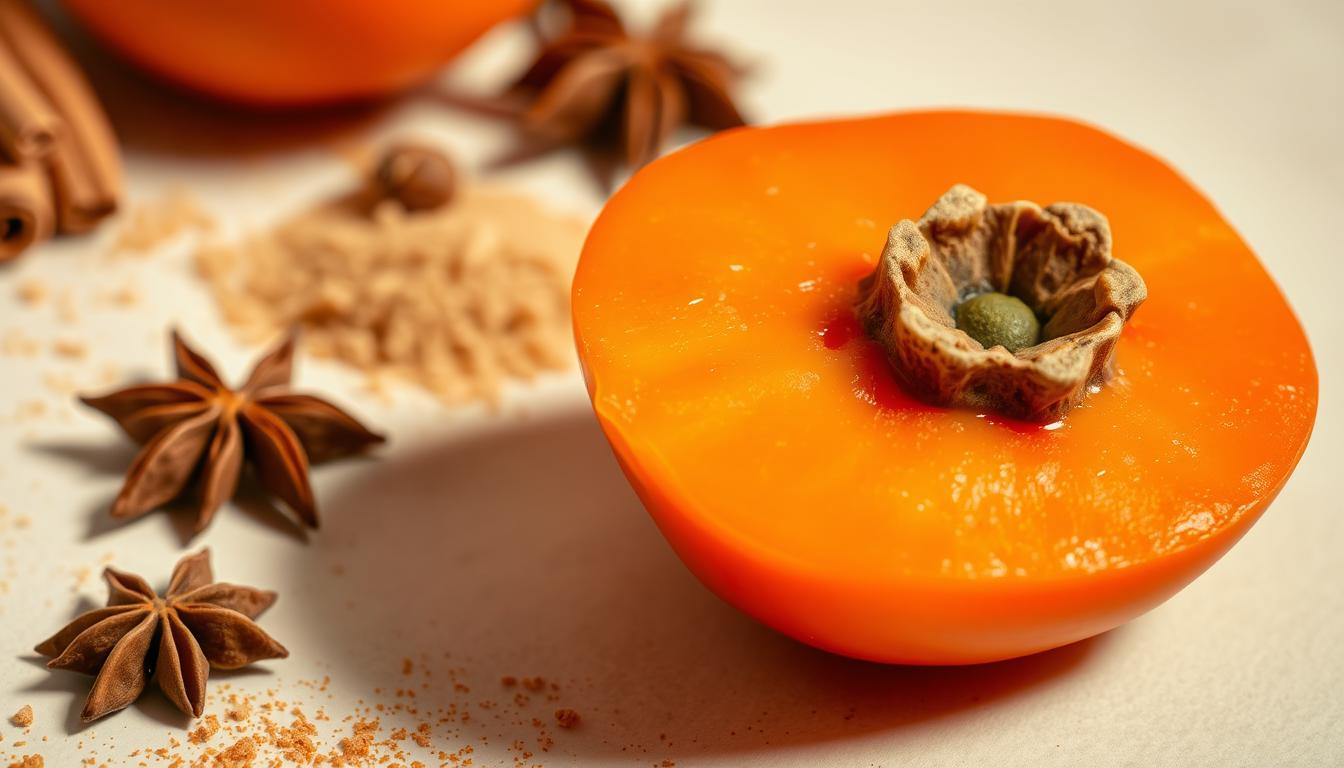What does a persimmon taste like?
Persimmons offer a unique and captivating flavor experience. Their taste transforms dramatically as they ripen. This fruit surprises many with its delightful blend of sweetness and complexity.
Picture a fruit that combines mango and roasted sweet pepper. It has subtle hints of cinnamon and dates. Each bite of a persimmon is an exciting culinary adventure.
Ripeness is key to enjoying this remarkable fruit. Unripe persimmons can taste tart or bitter. When perfectly mature, they offer an intensely sweet, honey-like flavor.
The texture of persimmons varies widely. It can range from firm to incredibly soft. This depends on the variety and how ripe the fruit is1.
Key Takeaways
- Persimmons offer a unique flavor that blends multiple taste profiles
- Ripeness dramatically affects the fruit’s taste and texture
- Different varieties have distinct flavor characteristics
- The fruit transforms from tart to sweet when fully ripe
- Persimmons provide a complex and enjoyable eating experience
Understanding Different Types of Persimmons
Persimmons are fascinating fruits with remarkable diversity. They offer unique flavors and textures that delight food lovers. These fruits come in several varieties, each with distinctive characteristics2.
North American markets feature two main Asian persimmon varieties. These types showcase incredible culinary potential2.
Fuyu Persimmons: Crisp and Sweet Delights
Fuyu persimmons are round, squat fruits resembling beefsteak tomatoes. They offer exceptional versatility and a honey-like flavor. Fuyu persimmons can be enjoyed when firm or slightly soft34.
- Brix level ranges from 11 to 13
- Can be eaten raw or used in multiple recipes
- Ideal for salads, smoothies, and roasting
Hachiya Persimmons: The Soft and Complex Variety
Hachiya persimmons are elongated, heart-shaped fruits requiring careful ripening. When fully ripe, they develop a pudding-like interior. These persimmons offer a remarkable depth of flavor32.
- Astringent until completely softened
- Best when feeling like a water balloon
- Excellent for baking and desserts
American Persimmons: A Native Treasure
American persimmons are less common but offer a unique taste profile. These native fruits bring a wild, complex flavor. They’re often described as having intense tartness and remarkable depth3.
Each persimmon variety promises a distinctive culinary adventure. Food lovers can explore their remarkable range of flavors and textures2.
Complete Persimmon Taste Description
Persimmons offer a unique flavor story with each bite. Their taste ranges from honey-sweet to deeply complex. The aroma hints at spices like cinnamon and nutmeg, creating an enchanting experience5.
Persimmon textures vary by type. Non-astringent Fuyu are crisp and firm. Astringent Hachiya become jelly-like when ripe5.
The flavor profile blends:
- Ripe apple sweetness
- Apricot undertones
- Subtle date-like richness
Persimmons are versatile in cooking. They can be eaten fresh or used in desserts and savory dishes. Their unique sweetness enhances many recipes6.
Ripening changes persimmon taste. Unripe fruits are tannic and bitter. Ripe ones have a luscious, honey-like flavor5.
For the best taste, let Hachiya persimmons ripen until almost pudding-like. This captures autumn’s most intriguing fruit6.
Curious about persimmons? Learn more about this remarkable fruit and its unique qualities.
Conclusion
Persimmons offer a unique flavor that captivates taste buds. They transform from astringent to sweet, making them a culinary adventure. Fuyu and Hachiya varieties provide distinct taste experiences7.
Nutritionally, persimmons are powerhouses. A ripe fruit has 118 calories and 6 grams of fiber. Their texture ranges from custard-like to slightly crunchy7.
Packed with vitamins A and C, persimmons act as natural antioxidants. They support overall wellness and make a great addition to healthy diets.
Persimmons offer endless culinary possibilities. Enjoy Fuyu in fresh salads or use Hachiya in baking. Patience is key – let the fruit ripen fully for the best flavor7.
Try the persimmon adventure. Visit farmers markets and experiment with different varieties. Your taste buds will love exploring this often-overlooked fruit’s sweet and complex world.
FAQ
What do persimmons taste like?
Are persimmons sweet or tart?
How do I know when a persimmon is ripe?
Can you eat persimmons raw?
What do persimmons smell like?
How do different persimmon varieties taste?
Are persimmons good for you?
How can I use persimmons in cooking?
Source Links
- Persimmons Are a Fruit You Should Have on Your Radar – https://www.simplyrecipes.com/what-are-persimmons-5104436
- What Are Persimmons? And What Do They Taste Like? – https://www.southernliving.com/food/fruits/what-is-a-persimmon?srsltid=AfmBOopcz1rSQ3rfiwRUX7C82-U-vyjd49XQM2YZvuskYFSzdrLgn9uG
- Fuyu vs. Hachiya Persimmons – Explained! – https://blog.bostonorganics.com/fuyu-vs-hachiya-persimmons-explained
- All About Persimmons and Persimmon Varieties – https://www.seriouseats.com/persimmons
- What Does Persimmon Taste Like? FAQ – https://www.eatyourbeets.com/what-does-persimmon-taste-like/
- What Are Persimmons? And What Do They Taste Like? – https://www.southernliving.com/food/fruits/what-is-a-persimmon?srsltid=AfmBOormb2Gw7EcTdcSNtr3SIsuX3ugkmBYQ4XV2rnOgLqFDVCNk9-00
- What Does a Persimmon Taste Like? – https://thekitchencommunity.org/what-does-a-persimmon-taste-like/
news via inbox
Nulla turp dis cursus. Integer liberos euismod pretium faucibua








